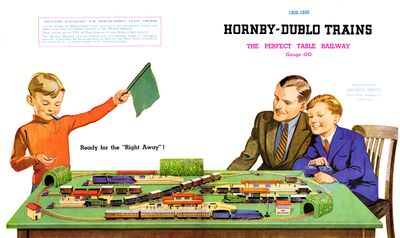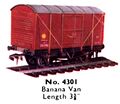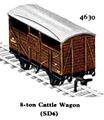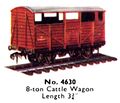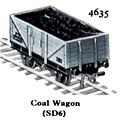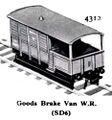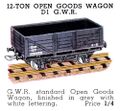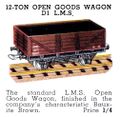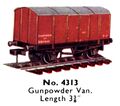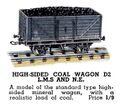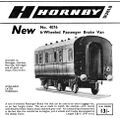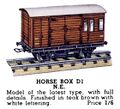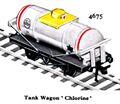Category:Hornby Dublo
| Toy Brands and Manufacturers |
|---|
Hornby Dublo |
1938 brochure. Note the repetition of the two loco types [image info]
1939: "Hornby Dublo, The Perfect Table Railway" [image info]
Dublo logo, blue and white packaging [image info]
Hornby's 00-gauge system, Dublo ("Double-Oh") was launched in 1938 as a fully-fledged system, with locomotives, rolling-stock, track, scenery and stations.
The Dublo trains and rolling-stock were still metal, but the smaller scale made wood a natural choice for the stations.
Launch, 1938
The range launched with just two locomotives: A tank loco, and a blue "Sir Nigel Gresley" streamlined LNER A4 passenger express locomotive.
A more conventional (unstreamlined) passenger loco was scheduled for 1939 (the "Duchess of Atholl" set), but the outbreak of WW2 meant that it couldn't go into production until after hostilities had ceased.
The Dublo range expanded after WW2, largely replacing the bigger Gauge 0 sets.
Development and two-rail problems
Hornby aggressively expanded the range after WW2, dropping the clockwork locomotives and initially focusing on a three-rail electric system. However, the longer-term aim was to transition towards a less expensive two-rail system, and even though Meccano Ltd. started converting rolling stock ahead of the changeover (so that the wagon and carriage wheels wouldn't short-circuit a two-rail sytem), the company ran into some serious teething problems. Hornby's original points system was designed for electrical reliability, but required special insulating sections to prevent "shorts", leaving some customers annoyed that the new "cheaper and simpler" two-rail system was actually creating more complexity, especially since there were some sorts of layout, such as a closed loop at the end of a spur, which would cause a polarity-reversal in the tracks and create short-circuits unless more of the special extra "insulating track" sections were used.
This didn't please existing three-rail Dublo owners, some of whom were already annoyed that the two-rail system often wasn't as conducive to a good electrical contact between locomotive and track - with two-rail, the wheels tended to roll a layer of dust and grease onto the track, whereas with three-rail, the centre "electrical" rail was constantly scraped by the loco's electrical pickup, cleaning it, while the return path went through two sets of rolled contacts, so there was only one "troublesome" rail connection, which was shared over two sets of wheels and rails, reducing the risk of a problem serious enough to stop a train.
Hornby responded to the problem of points complexity by releasing new "Simplec" points (~1963) which didn't need isolator sections, but these appeared quite late in Dublo's life.
The end of Dublo
The difficulties in the switch to two-rail is blamed by some for Meccano Ltd's financial problems, but the "indestructible" Dublo designs, with their high-quality diecast point-bases and solid cast-metal locomotive chassis were inherently expensive to produce, especially when other manufacturers were embracing plastic and cheaper construction methods. While cheaper train-set designs could be continuously improved in quality, Dublo could not easily be manufactured more cheaply without a switch in manufacturing methods, at which point the company would be at a disadvantage compared to competitors who had been using those methods for years.
While enthusiasts might be happy to pay a premium for quality and longevity, parents who just wanted to put a train set of some sort under the Christmas tree often chose cheaper alternatives to Hornby, and after Triang bought Meccano they ceased production of Dublo and replaced it with a range based on the existing "Triang Rovex" range, renamed "Triang Hornby".
External links
Subcategories
This category has the following 16 subcategories, out of 16 total.
D
- Dublo 1938 (6 P, 23 F)
- Dublo 1939 (53 F)
- Dublo Dinky Toys (15 P, 30 F)
H
- Hornby Dublo buildings - metal (5 P, 12 F)
- Hornby Dublo buildings - plastic (3 P, 11 F)
- Hornby Dublo buildings - wood (3 P, 13 F)
- Hornby Dublo Low-sided Wagons (4 P, 9 F)
- Hornby Dublo train sets (8 P, 7 F)
- Hornby Dublo two-rail system (6 F)
R
- Ring Field motors (2 P, 4 F)
Pages in category ‘Hornby Dublo’
The following 107 pages are in this category, out of 107 total.
A
B
- Barnstaple Pullman train set 2035 (Hornby Dublo)
- Bedford Articulated Truck (Dublo Dinky Toys 072)
- Bedford Flat Truck (Dublo Dinky Toys 066)
- Blue Spot Fish Van E87231 (Hornby Dublo 4300)
- Bogie Bolster Wagon D1 (Hornby Dublo 4610)
- BR Class 08 diesel shunter D3302 (Hornby Dublo 2231)
- BR Class 55 Deltic diesel locomotive D9012 "Crepello" (Hornby Dublo 2234)
- Brake Van LNER 178717 (Hornby Dublo D1)
- Breakdown Crane (Hornby Dublo 4620)
- Bristol Castle locomotive 7013, EDLT20 (Hornby Dublo)
- Bulk Grain Wagon (Hornby Dublo 4625)
C
- Cable Drum (Hornby Dublo 1521)
- Canadian Pacific Caboose 437270 (Hornby Dublo)
- Canadian Pacific locomotive 1215 (Hornby Dublo)
- Cattle Truck 8-ton GWR 106324 (Hornby Dublo D1)
- Cattle Truck GWR 106324 (Hornby Dublo D1)
- Cattle Wagon 8-Ton B893344 SD6 (Hornby Dublo 4630)
- City of Liverpool locomotive 46247 (Hornby Dublo 3226)
- Coal Wagon LMS 210112 (Hornby Dublo D1)
- Coal Wagon LNER 404844 (Hornby Dublo D1)
- Commer Express Delivery Van (Dublo Dinky Toys 063)
- Corridor Coach WR First-Second Class, W15870 (Hornby Dublo 4050)
- Corridor Coach, 1st-3rd teak, LNER 42759 (Hornby Dublo D1)
D
F
G
- Goods Brake Van GW 68796 Park Royal (Hornby Dublo D1)
- Goods Brake Van SD6 BR B950350 (Hornby Dublo 4311)
- Goods Depot D1, wooden (Hornby Dublo)
- Goods Shed Moulded Kit (Hornby Dublo 5020)
- Goods Train Set, GWR, Tank Loco 6699 (Hornby Dublo EDG7)
- Goods Train Set, SR (Hornby Dublo EDG7)
- Goods Van 12-Ton GWR 112699 (Hornby Dublo D1)
- Goods Van SR 48277 (Hornby Dublo D1)
H
K
L
M
P
R
S
- Saxa Salt Wagon SD6 (Hornby Dublo 4665)
- Signal Cabin D1, metal (Hornby Dublo 5080)
- Silver King streamlined A4 locomotive 60016 (Hornby Dublo)
- Singer Roadster (Dublo Dinky Toys 062)
- Single Arm Electric Signal ED1, Home (Hornby Dublo 5065)
- Single Arm Electric Signal ED1, Home (Hornby Dublo)
- Single-Arm Signal - Home, electric (Hornby Dublo 5065)
- Sir Nigel Gresley 4498 streamlined A4 locomotive, three-rail (Hornby Dublo D1)
- Six-Wheeled Passenger Brake Van M32958 (Hornby Dublo 4076)
- Southern Railway Electric Driving Trailer Coach, box (Hornby Dublo 4150)
- Southern Railway electric motor coach brake 2nd (Hornby Dublo 2250)
- Switch D1 (Hornby Dublo 32302)
- Switch D1 (Hornby Dublo 32303)
T
- Tank goods train set G16 (Hornby Dublo)
- Tank goods train set No.2008 (Hornby Dublo)
- Tank Locomotive 0-6-2, GWR 6699 (Hornby Dublo EDL7)
- Tank Locomotive 2-6-4 BR 80054 (Hornby Dublo EDL18)
- Tank Wagon D1, Esso (Hornby Dublo)
- Tank Wagon D1, Esso, black filler cap (Hornby Dublo)
- Tank Wagon D1, Royal Daylight (Hornby Dublo)
- Tank Wagon, Esso Royal Daylight Paraffin (Hornby Dublo)
- The end of Hornby Dublo
- Through Station D1, metal (Hornby Dublo 3465)
- TPO Post Office Mail Van Set (Hornby Dublo 2400)
- Two-Coach Articulated Unit LNER 45401 45402 (Hornby Dublo D2)
U
Media in category ‘Hornby Dublo’
The following 200 files are in this category, out of 361 total.
(previous page) (next page)- AEC Mercury Tanker (Dublo Dinky Toys 070).jpg 1,024 × 769; 600 KB
- Austin Lorry (Dublo Dinky Toys 064).jpg 1,024 × 576; 481 KB
- Austin Lorry, Dublo Dinky Toys 064 (HDBoT 1959).jpg 630 × 472; 53 KB
- Austin Lorry, underside (Dublo Dinky Toys 064).jpg 2,000 × 1,130; 1,001 KB
- Austin Taxi (Dublo Dinky Toys 067).jpg 1,024 × 769; 495 KB
- Banana Van, Hornby-Dublo 4301 (DubloCat 1963).jpg 818 × 709; 102 KB
- Bedford Flat Truck (Dublo Dinky Toys 066).jpg 1,024 × 577; 445 KB
- Bedford Flat Truck, Dublo Dinky Toys 066 (HDBoT 1959).jpg 842 × 650; 85 KB
- Blue Spot Fish Van, ER, Hornby Dublo 4300 (DubloCat 1963).jpg 842 × 671; 107 KB
- Bogie Bolster Wagon D1, Hornby Dublo 4610 (HDBoT 1959).jpg 1,623 × 1,010; 197 KB
- Bogie Bolster Wagon, Hornby Dublo 4610 (DubloCat 1963).jpg 1,180 × 588; 99 KB
- Bogie Well Wagon 40-Ton D1, Hornby Dublo 4605 (HDBoT 1959).jpg 1,554 × 923; 180 KB
- Bogie Well Wagon 40-ton, Hornby Dublo 4605 (DubloCat 1963).jpg 1,197 × 525; 84 KB
- Breakdown Crane No133, Hornby Dublo 4620, profile.jpg 1,637 × 411; 129 KB
- Breakdown Crane No133, Hornby-Dublo 4620 (DubloCat 1963).jpg 2,358 × 1,222; 259 KB
- Breakdown Train Set, box artwork (Hornby Dublo 2049).jpg 2,000 × 1,781; 325 KB
- Bristol Castle loco 7013, Turntable 3470 D1, Hornby Dublo (HDBoT 1959).jpg 2,200 × 1,233; 377 KB
- Buffer Stop D1, Hornby Dublo (HBoT 1939).jpg 568 × 387; 41 KB
- Buffer Stop D1, Hornby Dublo (MM 1958-01).jpg 402 × 345; 23 KB
- Buffer Stop, Hornby Dublo 2450 (HDBoT 1959).jpg 297 × 400; 20 KB
- Bulk Grain Wagon 20-Ton SD6, Hornby Dublo 4625 (HDBoT 1959).jpg 1,065 × 1,169; 203 KB
- Bulk Grain Wagon 20-ton, Hornby Dublo 4625 (DubloCat 1963).jpg 881 × 753; 114 KB
- Cattle Truck GWR, Hornby Dublo D1 (HBoT 1939).jpg 560 × 526; 80 KB
- Cattle Truck LMS, Hornby Dublo D1 (HBoT 1939).jpg 555 × 489; 77 KB
- Cattle Wagon 8-Ton SD6, Hornby Dublo 4630 (HDBoT 1959).jpg 937 × 1,077; 151 KB
- Cattle Wagon 8-ton, Hornby-Dublo 4630 (DubloCat 1963).jpg 847 × 730; 108 KB
- Chris Littledale, 'The Rise and Fall of Hornby Dublo' video, still.jpg 1,024 × 768; 281 KB
- City of London loco BR 46245, Hornby Dublo 2226 (HDBoT 1959).jpg 2,200 × 1,371; 293 KB
- City of London-Liverpool locomotives, Hornby Dublo 2226-3226 (DubloCat 1963).jpg 2,146 × 839; 284 KB
- City Station Outfit D2, Hornby Dublo (HBoT 1939).jpg 2,200 × 1,312; 513 KB
- City-Class locomotive drive gear, Hornby Dublo 2226 (HDBoT 1959).jpg 2,173 × 1,101; 227 KB
- Coal Wagon SD6, Hornby Dublo 4635 (HDBoT 1959).jpg 813 × 811; 104 KB
- Coal Wagon, Hornby Dublo D1 (HBoT 1939).jpg 1,144 × 940; 177 KB
- Coal Wagon. Hornby Dublo 4635 (DubloCat 1963).jpg 767 × 603; 81 KB
- Commer Van (Dublo Dinky Toys 063).jpg 1,024 × 770; 574 KB
- Commer Van, Dublo Dinky Toys 063 (HDBoT 1959).jpg 490 × 440; 40 KB
- Composite Sleeping Car, BR, Hornby-Dublo 4078 (DubloCat 1963).jpg 1,689 × 701; 213 KB
- Controller No1 No1a, Hornby Dublo (HBoT 1939).jpg 1,820 × 899; 248 KB
- Corridor Coach 1st 2nd, BR, Hornby Dublo 4052 (DubloCat 1963).jpg 1,669 × 756; 213 KB
- Corridor Coach 1st 2nd, SR, Hornby Dublo 4054 (DubloCat 1963).jpg 1,662 × 771; 220 KB
- Corridor Coach 1st-2nd D22, Hornby Dublo 4013 (HDBoT 1959).jpg 1,750 × 892; 226 KB
- Corridor Coach BR 1st-2nd D12, Hornby Dublo 4005 (HDBoT 1959).jpg 1,893 × 913; 239 KB
- Corridor Coach BR Brake-2nd D12, Hornby Dublo 4006 (HDBoT 1959).jpg 1,632 × 845; 217 KB
- Corridor Coach Brake-2nd D22, Hornby Dublo 4014 (HDBoT 1959).jpg 1,887 × 955; 266 KB
- Corridor Coach Brake-2nd WR, Hornby Dublo 4051 (DubloCat 1963).jpg 1,629 × 778; 210 KB
- Corridor Coach Brake-Second BR, Hornby Dublo 4053 (MM 1960-012).jpg 1,885 × 980; 229 KB
- Corridor Coach Brake-Second WR, Hornby Dublo 4051 (MM 1960-012).jpg 1,878 × 971; 219 KB
- Corridor Coach Brake-Third LMS, Hornby Dublo D3 (HBoT 1939).jpg 934 × 479; 115 KB
- Corridor Coach First-Second BR, Hornby Dublo 4052 (MM 1960-012).jpg 1,932 × 1,009; 238 KB
- Corridor Coach First-Second WR, Hornby Dublo 4050 (MM 1960-012).jpg 1,770 × 967; 202 KB
- Corridor Coach First-Third LMS, Hornby Dublo D3 (HBoT 1939).jpg 1,039 × 482; 146 KB
- Corridor Coach LNER, Hornby Dublo D1 (1938 Dublo brochure).jpg 801 × 387; 77 KB
- Corridor Coach LNER, Hornby Dublo D1 (HBoT 1939).jpg 887 × 466; 101 KB
- Corridor Coach WR 1st-2nd D21, Hornby Dublo 4009 (HDBoT 1959).jpg 1,911 × 967; 264 KB
- Corridor Coach WR Brake-2nd D21, Hornby Dublo 4010 (HDBoT 1959).jpg 1,649 × 887; 218 KB
- DC Converter, Hornby Dublo (HBoT 1939).jpg 2,014 × 899; 247 KB
- Denbigh Castle loco BR 7032, Hornby Dublo 2220 (HDBoT 1959).jpg 2,200 × 1,260; 280 KB
- Diesel-Electric 0-6-0 Shunting Engine, Hornby Dublo 2231 (MM 1960-012).jpg 2,149 × 1,717; 418 KB
- Diesel-Electric Co-Co Locomotive, Hornby Dublo 2232 (MM 1960-012).jpg 2,200 × 1,424; 424 KB
- Diesel-Electric Type 1 Bo-Bo locomotive BR D8000, Hornby Dublo 2230 (HDBoT 1959).jpg 2,200 × 1,593; 544 KB
- Double Bolster Wagon with Timber Load, Hornby Dublo 4615 (DubloCat 1963).jpg 1,003 × 598; 103 KB
- Double Bolster Wagon with Timber Load, Hornby Dublo 4615 (HDBoT 1959).jpg 1,208 × 1,036; 160 KB
- Dublo Dinky Toys (MM 1957-12).jpg 908 × 375; 73 KB
- Dublo Dinky Toys (MM 1960-03).jpg 1,200 × 291; 61 KB
- Dublo Dinky Toys 064 - Austin Lorry (MM 1957-12).jpg 2,729 × 850; 264 KB
- Dublo Dinky Toys 065 - Morris Pickup (MM 1957-12).jpg 2,726 × 798; 178 KB
- Dublo Dinky Toys 066 - Bedford Flat Truck (MM 1957-12).jpg 2,723 × 1,422; 374 KB
- Dublo low-priced train sets 2006 2007 (MM 1960-03).jpg 1,522 × 2,200; 500 KB
- Dublo Transformers, Hornby Dublo (HBoT 1939).jpg 1,839 × 893; 266 KB
- Duchess of Atholl 6231, Hornby Dublo loco EDLT2 (HBoT 1939).jpg 2,000 × 521; 94 KB
- Duchess of Atholl loco, boxed (Hornby Dublo).jpg 1,024 × 768; 485 KB
- Duchess of Atholl Train Set Hornby Dublo EDP2 (HBoT 1939).jpg 3,303 × 2,478; 1.11 MB
- Electric Driving Trailer Coach S77511, SR, Hornby-Dublo 4150 (DubloCat 1963).jpg 1,694 × 692; 234 KB
- Electric Pantograph 3300hp Locomotive, Hornby-Dublo 2245 3245 (DubloCat 1963).jpg 2,080 × 1,348; 402 KB
- Elevated Track, Hornby Acho (DubloCat 1963).jpg 3,466 × 1,102; 543 KB
- Engine Shed D1, Hornby Dublo (HBoT 1939).jpg 1,458 × 1,254; 320 KB
- Engine Shed Kit (two-road), Hornby Dublo 5005 (DubloCat 1963).jpg 1,308 × 749; 169 KB
- Engine Shed Kit, polystyrene, Hornby Dublo 5005 (MM 1961-06).jpg 2,045 × 1,247; 342 KB
- Engine Shed Moulded Kit, four road, Hornby Dublo 5006 (HDBoT 1959).jpg 2,200 × 1,106; 330 KB
- Engine Shed, Hornby Dublo D1 (1939-).jpg 632 × 540; 76 KB
- Esso Fuel Oil Tank Wagon, Hornby Dublo 4680 (DubloCat 1963).jpg 728 × 692; 92 KB
- Esso Tank Wagon, Hornby Dublo 4676 (DubloCat 1963).jpg 828 × 686; 95 KB
- FH-70 - Hornby Dublo (1938).jpg 1,080 × 1,920; 894 KB
- Fish Van NE, Hornby Dublo D1 (HBoT 1939).jpg 569 × 519; 81 KB
- Footbridge D1, Hornby Dublo (HBoT 1939).jpg 464 × 352; 37 KB
- Footbridge D1, Hornby Dublo (MM 1958-01).jpg 940 × 671; 90 KB
- Footbridge, Hornby Dublo D1 (1939-).jpg 640 × 531; 65 KB
- Ford Prefect car (Dublo Dinky Toys 061).jpg 1,024 × 770; 531 KB
- Ford Prefect, Dublo Dinky Toys 061 (HDBoT 1959).jpg 540 × 365; 35 KB
- Freight 8F 2-8-0 loco BR 48109, Hornby Dublo 2225 (HDBoT 1959).jpg 2,200 × 1,469; 414 KB
- Freight Locomotive 2-8-0 drive gear, Hornby Dublo 2225 (HDBoT 1959).jpg 1,929 × 1,008; 268 KB
- Fruit Van WR, Hornby Dublo 4305 (HDBoT 1959).jpg 1,524 × 1,324; 260 KB
- Girder Bridge D1, Hornby Dublo (MM 1958-01).jpg 912 × 476; 90 KB
- Girder Bridge, Hornby Dublo 5015 (DubloCat 1963).jpg 898 × 580; 89 KB
- Girder Bridge, Hornby Dublo D1 (MM 1957-02).jpg 1,465 × 2,200; 295 KB
- Golden Fleece loco BR 60030, Hornby Dublo 2211 (HDBoT 1959).jpg 2,200 × 1,381; 301 KB
- Golden Fleece locomotive 60030, Hornby Dublo 2211 (DubloCat 1963).jpg 2,420 × 893; 363 KB
- Goods Brake Van BR SD6, Hornby Dublo 4311 (HDBoT 1959).jpg 969 × 997; 145 KB
- Goods Brake Van GW, Hornby Dublo D1 (DubloBrochure 1938).jpg 545 × 505; 81 KB
- Goods Brake Van GW, Hornby Dublo D1 (HBoT 1939).jpg 569 × 512; 76 KB
- Goods Brake Van LMR SD6, Hornby Dublo 4310 (HDBoT 1959).jpg 929 × 955; 144 KB
- Goods Brake Van LMS, Hornby Dublo D1 (DubloBrochure 1938).jpg 536 × 499; 80 KB
- Goods Brake Van LMS, Hornby Dublo D1 (HBoT 1939).jpg 575 × 519; 73 KB
- Goods Brake Van LNER, Hornby Dublo D1 (DubloBrochure 1938).jpg 537 × 515; 70 KB
- Goods Brake Van LNER, Hornby Dublo D1 (HBoT 1939).jpg 583 × 503; 69 KB
- Goods Brake Van SR, Hornby Dublo D1 (DubloBrochure 1938).jpg 531 × 503; 73 KB
- Goods Brake Van SR, Hornby Dublo D1 (HBoT 1939).jpg 552 × 492; 74 KB
- Goods Brake Van WR SD6, Hornby Dublo 4312 (HDBoT 1959).jpg 933 × 998; 146 KB
- Goods Brake Van, BR, Hornby Dublo 4311 (DubloCat 1963).jpg 849 × 721; 96 KB
- Goods Brake Van, LMR, Hornby Dublo 4310 (DubloCat 1963).jpg 884 × 678; 109 KB
- Goods Brake Van, WR, Hornby-Dublo 4312 (DubloCat 1963).jpg 891 × 737; 105 KB
- Goods Depot D1, Hornby Dublo (1939-).jpg 695 × 445; 58 KB
- Goods Depot D1, Hornby Dublo (HBoT 1939).jpg 870 × 551; 88 KB
- Goods Depot Kit with crane Hornby Dublo 5020 (DubloCat 1963).jpg 1,450 × 819; 147 KB
- Goods Depot Kit, polystyrene, Hornby Dublo 5020 (MM 1961-06).jpg 1,869 × 1,039; 193 KB
- Goods Locomotive 48073 8F 2-8-0, Hornby-Dublo 2224 3224 (DubloCat 1963).jpg 1,909 × 997; 284 KB
- Goods Shed Moulded Kit, Hornby Dublo 5020 (HDBoT 1959).jpg 1,963 × 1,098; 315 KB
- Goods Train Set, Hornby Dublo EDG7 (DubloBrochure 1938).jpg 2,118 × 871; 429 KB
- Goods Van 12-Ton GWR, Hornby Dublo D1 (DubloBrochure 1938).jpg 503 × 503; 74 KB
- Goods Van 12-Ton GWR, Hornby Dublo D1 (HBoT 1939).jpg 576 × 516; 57 KB
- Goods Van 12-Ton LMS, Hornby Dublo D1 (DubloBrochure 1938).jpg 499 × 483; 73 KB
- Goods Van 12-Ton LMS, Hornby Dublo D1 (HBoT 1939).jpg 562 × 498; 72 KB
- Goods Van 12-Ton LNER, Hornby Dublo D1 (DubloBrochure 1938).jpg 507 × 545; 81 KB
- Goods Van 12-Ton LNER, Hornby Dublo D1 (HBoT 1939).jpg 571 × 533; 70 KB
- Goods Van 12-Ton SR, Hornby Dublo D1 (DubloBrochure 1938).jpg 489 × 511; 70 KB
- Goods Van 12-Ton SR, Hornby Dublo D1 (HBoT 1939).jpg 561 × 508; 52 KB
- Goods Wagon Open 12-Ton SR, Hornby Dublo D1 (DubloBrochure 1938).jpg 503 × 489; 72 KB
- Goods Wagon Steel type SD6, Hornby Dublo 4640 (HDBoT 1959).jpg 951 × 923; 143 KB
- Goods Wagon, Steel Type, Hornby Dublo 4640 (DubloCat 1963).jpg 801 × 596; 82 KB
- Gradient Post, Hornby Dublo 5025 (HDBoT 1959).jpg 313 × 411; 22 KB
- Gunpowder Van, Hornby-Dublo 4313 (DubloCat 1963).jpg 758 × 668; 88 KB
- High-Capacity Wagon, Hornby Dublo D1 (HBoT 1939).jpg 878 × 464; 104 KB
- High-Sided Coal Wagon, Hornby Dublo D2 (HBoT 1939).jpg 1,144 × 1,004; 212 KB
- High-Sided Wagon LMS, Hornby Dublo D2 (HBoT 1939).jpg 577 × 511; 80 KB
- High-Sided Wagon LNER, Hornby Dublo D2 (HBoT 1939).jpg 570 × 467; 70 KB
- Hopper Wagon 21-ton, Hornby Dublo 4644 (DubloCat 1963).jpg 830 × 664; 101 KB
- Hornby Dublo 2-8-0 Freight Locomotive 48158, LT25 (MM 1958-09).jpg 1,620 × 2,282; 824 KB
- Hornby Dublo 4076 6-wheeled Passenger Brake Van (MM 1963-10).jpg 970 × 950; 156 KB
- Hornby Dublo 4644 21-Ton Hopper Wagon (MM 1963-10).jpg 1,068 × 658; 96 KB
- Hornby Dublo Accessories (MM 1958-01).jpg 1,054 × 1,558; 295 KB
- Hornby Dublo Book of Trains (1959), front cover.jpg 2,200 × 1,668; 755 KB
- Hornby Dublo Book of Trains advert (MM 1959-11).jpg 1,653 × 2,407; 659 KB
- Hornby Dublo Book of Trains, accessories spread, p36-37.jpg 2,200 × 1,090; 822 KB
- Hornby Dublo brochure 1938.jpg 1,600 × 950; 357 KB
- Hornby Dublo City Station Outfit D2 (1939-).jpg 919 × 1,536; 243 KB
- Hornby Dublo couplings (HDBoT 1959).jpg 1,552 × 1,235; 317 KB
- Hornby Dublo DA Curved Rail (1938 Dublo brochure).jpg 721 × 366; 64 KB
- Hornby Dublo DB Straight Rail (1938 Dublo brochure).jpg 701 × 561; 97 KB
- Hornby Dublo EDPR Points, Electric (1938 Dublo brochure).jpg 697 × 459; 74 KB
- Hornby Dublo Electric Trains catalogue (MM 1960-10).jpg 1,062 × 1,600; 321 KB
- Hornby Dublo Electric Trains, overview (MCat 1956-07).jpg 3,000 × 1,866; 1.11 MB
- Hornby Dublo footbridge detail.jpg 1,024 × 972; 598 KB
- Hornby Dublo Goods Brake Van SD6, LT25 (MM 1958-09).jpg 1,589 × 2,213; 628 KB
- Hornby Dublo Goods Depot D1.jpg 800 × 600; 259 KB
- Hornby Dublo Island Platform D1 (1939).jpg 972 × 455; 56 KB
- Hornby Dublo Layouts advert (MM 1958-01).jpg 1,057 × 1,371; 232 KB
- Hornby Dublo LNER Silver King A4 locomotive 60016 detail.jpg 800 × 600; 236 KB
- Hornby Dublo logo, box detail.jpg 800 × 600; 370 KB
- Hornby Dublo logo.jpg 439 × 175; 17 KB
- Hornby Dublo Look out for developments (1938 Dublo brochure).jpg 1,233 × 1,437; 245 KB
- Hornby Dublo Mainline Station D1 (1939-).jpg 1,164 × 407; 79 KB
- Hornby Dublo pieces retained in the Triang Hornby range (THMCat 1965).jpg 2,400 × 1,563; 789 KB
- Hornby Dublo SD6 Super Detail rolling stock (MM 1958-10).jpg 2,941 × 2,241; 755 KB
- Hornby Dublo styrene station 5083.jpg 800 × 600; 298 KB
- Hornby Dublo Super Detail (MM 1960-04).jpg 2,799 × 946; 146 KB
- Hornby Dublo Three Rail Track (HDBoT 1959).jpg 2,000 × 1,822; 556 KB
- Hornby Dublo Train Name Labels (MM 1958-10).jpg 3,238 × 4,532; 1.44 MB
- Hornby Dublo Two-Rail Track (MM 1960-03).jpg 1,085 × 1,600; 306 KB
- Hornby Dublo Uncoupling Rail, detail.jpg 1,600 × 495; 520 KB
- Hornby Dublo, Superb Detail, Super Strength (MM 1958-05).JPG 1,091 × 1,600; 296 KB
- Hornby Dublo, The Perfect Table Railway (HBoT 1939).jpg 2,000 × 1,425; 558 KB
- Hornby Locomotive Part Exchange Coupon (MM 1960-09).jpg 557 × 742; 80 KB
- Hornby Simplec Points (MM 1963-10).jpg 1,088 × 1,414; 212 KB
- Hornby-Dublo box lid artwork, 1938.jpg 800 × 260; 133 KB
- Hornby-Dublo Bristolian Train Set EDP20 (MM 1957-12).jpg 1,478 × 2,180; 541 KB
- Hornby-Dublo Trains, centrespread (MM 1938-11).jpg 3,222 × 2,146; 1.02 MB
- Horse Box BR, Hornby Dublo Super Detail 4315 (MM 1960-04).jpg 1,684 × 1,088; 260 KB
- Horse Box NE, Hornby Dublo D1 (HBoT 1939).jpg 558 × 507; 81 KB
- Horse Box SR, Hornby Dublo Super Detail 4316 (MM 1960-04).jpg 1,734 × 1,103; 260 KB
- Horse Box with Horse BR, Hornby Dublo 4315 (HDBoT 1959).jpg 1,305 × 1,179; 193 KB
- Horse Box with Horse SR, Hornby Dublo 4316 (HDBoT 1959).jpg 1,395 × 1,270; 232 KB
- Horse Box with Horse, BR, Hornby Dublo 4315 (DubloCat 1963).jpg 997 × 728; 118 KB
- Horse Box with Horse, SR, Hornby Dublo 4316 (DubloCat 1963).jpg 997 × 756; 129 KB
- ICI Bulk Salt Wagon 20-ton, Hornby Dublo 4627 (DubloCat 1963).jpg 785 × 650; 84 KB
- ICI Caustic Liquor Bogie Wagon, Hornby-Dublo 4685 (DubloCat 1963).jpg 1,039 × 718; 127 KB
- ICI Chlorine Tank Wagon, Hornby Dublo 4675 (DubloCat 1963).jpg 812 × 737; 100 KB
- ICI Chlorine Tank Wagon, Hornby Dublo 4675 (HDBoT 1959).jpg 1,193 × 1,033; 194 KB
- Island Platform D1, Hornby Dublo (HBoT 1939).jpg 2,200 × 597; 167 KB
- Island Platform D1, metal, Hornby Dublo (MM 1958-01).jpg 1,770 × 572; 121 KB

